6 January 2011
Book review video: Climate change
Links, mostly to Amazon pages for the 6 books mentioned in the video:
Ice, Mud, & Blood by Chris Turney
Turney’s Twitter stream from Antarctica
What’s the Worst that Could Happen? by Greg Craven
Link to the AGU10 blog post mentioned and to Greg Craven’s response.
Plows, Plagues, and Petroleum by William Ruddiman
Link to an earlier review I wrote about CO2 Rising.
5 January 2011
Dirt: the Erosion of Civilizations, by David Montgomery
The final book I read over the break was Dirt: the Erosion of Civilizations, by David Montgomery.
Montgomery got a MacArthur “Genius” Award for his soil work, and I use an article he wrote for GSA Today (2007) as one of the assigned readings for my Environmental Geology course. In Dirt, he lays out the case for protecting civilization by protecting soils. Attention is given to soil-forming processes, and rates of soil generation versus rates of denudation. He makes a compelling argument that when soil fertility declines, conflict ensues. He follows Jared Diamond’s argument from Collapse that insufficient land (soil) to feed oneself resulted in the Rwanda genocide, and makes a similar argument for the economic roots of the U.S. Civil War. The Dust Bowl, of course, gets a proper discussion. Montgomery tickles history with curiosity, probing for soil stories of the past: it’s one of the things about the book that I wasn’t expecting, and I really enjoyed it.
One thing I was definitely expecting from the book was for him to make the environmental case for sustainable soil practices, and he definitely does that. He lays out the case for terracing, no till farming, and composting with many examples, including his own yard in Seattle, full of “coffee-colored earthworms.” I was inspired to put a significant amount of energy into improving my own little plot of earth, if only I had one. (I live in a condo in the middle of a very urban area, with no yard.) Someday, though, I will enhance some lucky plot of soil with my banana peels and espresso grounds.
You should read Dirt. It’s fundamental to our nature as Earthlings that we are made of Earth, but this fact is unappreciated by many. Reading this book made me appreciate how essential this fact is, and how much of our civilization’s supporting fuel we have already squandered through carelessness and thoughtlessness. By putting some thought towards dirt, we may be inspired to care about it more.
Dirt: the Erosion of Civilizations, by David Montgomery
The final book I read over the break was Dirt: the Erosion of Civilizations, by David Montgomery.
Montgomery got a MacArthur “Genius” Award for his soil work, and I use an article he wrote for GSA Today (2007) as one of the assigned readings for my Environmental Geology course. In Dirt, he lays out the case for protecting civilization by protecting soils. Attention is given to soil-forming processes, and rates of soil generation versus rates of denudation. He makes a compelling argument that when soil fertility declines, conflict ensues. He follows Jared Diamond’s argument from Collapse that insufficient land (soil) to feed oneself resulted in the Rwanda genocide, and makes a similar argument for the economic roots of the U.S. Civil War. The Dust Bowl, of course, gets a proper discussion. Montgomery tickles history with curiosity, probing for soil stories of the past: it’s one of the things about the book that I wasn’t expecting, and I really enjoyed it.
One thing I was definitely expecting from the book was for him to make the environmental case for sustainable soil practices, and he definitely does that. He lays out the case for terracing, no till farming, and composting with many examples, including his own yard in Seattle, full of “coffee-colored earthworms.” I was inspired to put a significant amount of energy into improving my own little plot of earth, if only I had one. (I live in a condo in the middle of a very urban area, with no yard.) Someday, though, I will enhance some lucky plot of soil with my banana peels and espresso grounds.
You should read Dirt. It’s fundamental to our nature as Earthlings that we are made of Earth, but this fact is unappreciated by many. Reading this book made me appreciate how essential this fact is, and how much of our civilization’s supporting fuel we have already squandered through carelessness and thoughtlessness. By putting some thought towards dirt, we may be inspired to care about it more.
4 January 2011
Diamictite close-ups
Here’s three shots of the Konnarock Formation diamictite, taken with my Nikon microscope. Field of view is about 1 cm in each shot.
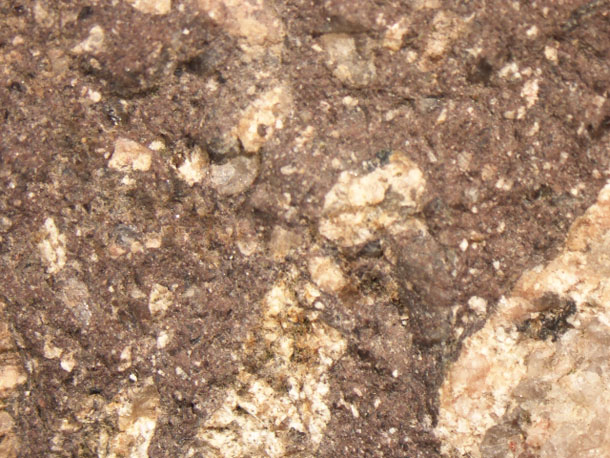

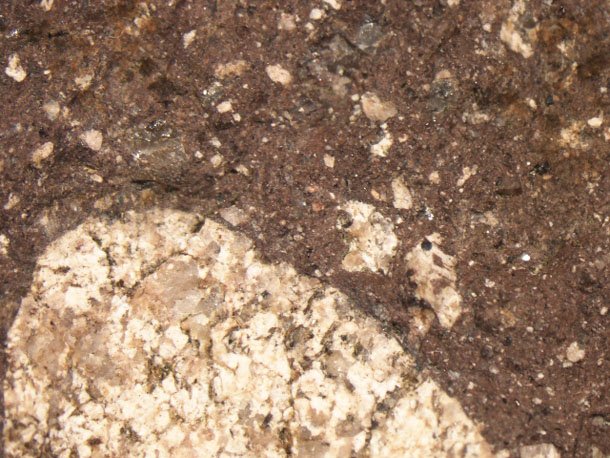
Fads and Fallacies in the Name of Science, by Martin Gardner
Yesterday I mentioned some books that I had sampled on the topic of geologic time over the holiday break.
Another book I read in my hammock in the Gulf of Honduras was Fads and Fallacies in the Name of Science, by Martin Gardner. As with Demon-Haunted World, I got the recommendation to read Gardner from a podcast that I listen to called The Skeptic’s Guide to the Universe. When Martin Gardner died earlier this year, the SGU Crew paid tribute to him on the podcast, and mentioned that anyone interested in skepticism and pseudoscience should read his classic 1952 book (reprinted in 1957 with some material added, in the edition that I read).
Gardner skewers flying saucer sightings, ESP, Atlantis, orgone accumulators, a dozen different bizarre forms of medical therapy, dianetics, and past life regression, as well as many others. It really ranges across a diverse smorgasbord of credulous tomfoolery. Maybe even the book could be criticized for taking on so many dumb ideas — it’s noble of Gardner to hold each of them up to scrutiny and pillory, but it does get a bit old by the end of the book. I mean, “X is wrong and stupid” gets a bit stale by the 200th time you read it.
An early chapter is devoted to the asinine notion of Immanuel Velikovsky that a giant comet erupted from Jupiter, interacting with the Earth in catastrophic ways including generating a giant flood (hmm, that sounds familiar...) and makes the Sun stand still (again, there’s a ring of something Biblical about that...) and parts the Red Sea (dang, what could Velikovsky’s motivation possibly be?). These ideas informed groups as wrongheaded as extraterrestrial pyramidologists and Flood “geologists”, and it was useful for me to review a secondary source critiquing Velikovsky’s ideas.
Martin Gardner eviscerates these exotic, tangled notions as if he were hacking through the upper Orinoco basin with a machete. He’s very cheerful and bemused, but doesn’t hesitate to call ridiculous “ridiculous,”‘ or refrain from delineating fraudulent behavior just because it isn’t polite to do so.
What would we call the reverse of an echo? You know, like a noise that came earlier in time than the echo? Arghh — I don’t have a word for it. Well, if Sagan was the echo, then Gardner was the original noise, at least as far as debunking pseudoscience is concerned. Reading Fads and Fallacies so soon after Demon-Haunted World I saw the overlap between the two authors’ fields of interest. While some of the flimflam that Gardner debunked died out between his time and Sagan’s, there are other topics that grew stronger despite both skeptics’ best efforts. From an historical perspective, this makes the two books an interesting exercise in comparison & contrast.
Fads and Fallacies in the Name of Science, by Martin Gardner
Yesterday I mentioned some books that I had sampled on the topic of geologic time over the holiday break.
Another book I read in my hammock in the Gulf of Honduras was Fads and Fallacies in the Name of Science, by Martin Gardner. As with Demon-Haunted World, I got the recommendation to read Gardner from a podcast that I listen to called The Skeptic’s Guide to the Universe. When Martin Gardner died earlier this year, the SGU Crew paid tribute to him on the podcast, and mentioned that anyone interested in skepticism and pseudoscience should read his classic 1952 book (reprinted in 1957 with some material added, in the edition that I read).
Gardner skewers flying saucer sightings, ESP, Atlantis, orgone accumulators, a dozen different bizarre forms of medical therapy, dianetics, and past life regression, as well as many others. It really ranges across a diverse smorgasbord of credulous tomfoolery. Maybe even the book could be criticized for taking on so many dumb ideas — it’s noble of Gardner to hold each of them up to scrutiny and pillory, but it does get a bit old by the end of the book. I mean, “X is wrong and stupid” gets a bit stale by the 200th time you read it.
An early chapter is devoted to the asinine notion of Immanuel Velikovsky that a giant comet erupted from Jupiter, interacting with the Earth in catastrophic ways including generating a giant flood (hmm, that sounds familiar...) and makes the Sun stand still (again, there’s a ring of something Biblical about that...) and parts the Red Sea (dang, what could Velikovsky’s motivation possibly be?). These ideas informed groups as wrongheaded as extraterrestrial pyramidologists and Flood “geologists”, and it was useful for me to review a secondary source critiquing Velikovsky’s ideas.
Martin Gardner eviscerates these exotic, tangled notions as if he were hacking through the upper Orinoco basin with a machete. He’s very cheerful and bemused, but doesn’t hesitate to call ridiculous “ridiculous,”‘ or refrain from delineating fraudulent behavior just because it isn’t polite to do so.
What would we call the reverse of an echo? You know, like a noise that came earlier in time than the echo? Arghh — I don’t have a word for it. Well, if Sagan was the echo, then Gardner was the original noise, at least as far as debunking pseudoscience is concerned. Reading Fads and Fallacies so soon after Demon-Haunted World I saw the overlap between the two authors’ fields of interest. While some of the flimflam that Gardner debunked died out between his time and Sagan’s, there are other topics that grew stronger despite both skeptics’ best efforts. From an historical perspective, this makes the two books an interesting exercise in comparison & contrast.
3 January 2011
Four books on time
Over the holiday break, I did a lot of reading. I love to read, but my schedule is so busy during the semester that I now consider it a real indulgence to lie back on the couch (or on a Honduran hammock) and just spend hours wrapped up in a book.
I read several books about geologic time, and I’d like to quickly offer some thoughts on them here:
The Age of the Earth by Brent Dalrymple is an exhaustive account of the logic and data in support of our understanding of the age of the Earth as 4.54 billion years old. It is a profoundly comprehensive book, very much in a “review of the literature” style, with chapters dedicated to (1) early attempts at dating the Earth, (2) radiometric dating and how it works, setting aside the topic of lead isotopes, (3) old rocks on Earth, (4) moon rocks, (5) meteorites, (7) lead isotopes in particular, and (8) the age of the Universe, along with element fusion in stars and supernovae.
This is a really good book, and I’m glad I read it. I feel like I’ve got a better handle on isochrons, isotopes, and even the history of the nebular hypothesis as a result of reading it. It’s technical, but if you speak geology, you should enjoy it.
Dalrymple also wrote a more “user friendly” version of the book called Ancient Earth, Ancient Skies, which I checked out of the library but found to be redundant, since I just finished with the Age of the Earth. This one would be appropriate for undergraduate students or interested amateurs.
A different angle was taken in the book The Dating Game: One Man’s Search for the Age of the Earth, by Cherry Lewis. This is pretty much a biography of Arthur Holmes, a grand old geologist from the U.K. who contributed some fundamental ideas and data to the question of the age of the Earth. Holmes features prominently in Dalrymple’s books, too, but Lewis takes a much more personal tack. The reader explores Holmes’ life and career path with tangents into piano playing, romantic affairs, exotic travel, personal tragedy, and ultimately appreciation and vindication. It’s very entertaining, and well-written. It covers a smaller spectrum of the scientific story than Dalrymple, but it’s as much about context as it is science, so you’ll be entertained regardless.
The last book I checked out was The Bible, Rocks, and Time, by Davis Young and Ralph Stearley. This one was conceived of by two Christian geology professors at Calvin College, with the goal of setting straight for other Christians why the geologic record provides profound evidence for an ancient Earth, and why in their view that is compatible with Christian faith. I’m not a Christian, so I didn’t make it more than a few pages into this one. The table of contents looks promising for newbie readers who value frequent references to faith. It appears to be a book that would appeal to those Christians who need someone to tell them it’s okay to trust their own minds and material evidence, even when it directly contradicts a literal reading of their holy scripture. But I zonked out after 12 pages or so, so I couldn’t really tell you for sure. It’s even longer than Dalrymple’s The Age of the Earth, but a lot of that appears to be theological discussion. If you’re a young-Earth creationist, and want to hear from some old-Earth creationists about why “Flood Geology” is hooey, check out The Bible, Rocks, and Time. And let the rest of us know what you think.
1 January 2011
GoSF10: The San Andreas Fault & Mussel Rock
“GoSF” = Geology of San Francisco
Happy new year. Take it from me, nothing cures a hangover like traipsing across a plate boundary and thinking about one of the best geology books ever written. Mountain Beltway has been reviewing three field trips I took the week before last to check out the geology of San Francisco and neighboring areas. The overall plan (now complete) was to cover:
Fractures and the chemistry along them
The San Andreas Fault and Mussel Rock (today)
Our final stop on the two-year-college field trip was to the town of Pacifica, California, where the San Andreas Fault runs off the edge of the land and into the Pacific Ocean, running parallel to the Golden Gate Bridge and eventually coming ashore again adjacent to Point Reyes. (It runs underneath preternaturally-straight Tomales Bay.)
Here’s an animated view over the area where the San Andreas drops into the sea. Perspective shifts from the north to the east:
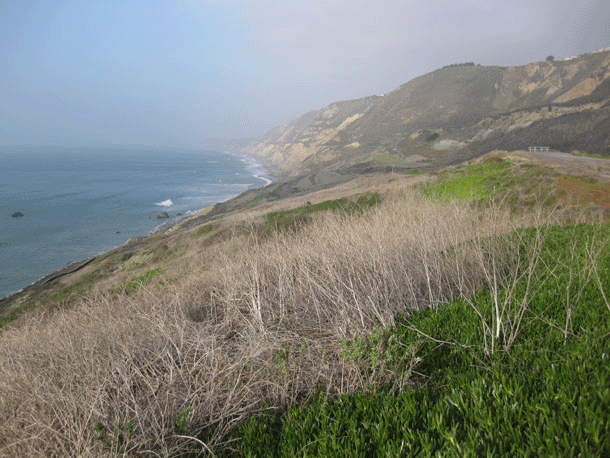
The viewpoint is looking from the Pacific Plate, across the transform (right lateral) plate boundary at the North American Plate. The land surface jumps up roughly along that boundary. Along that high bluff (landslide scarp) you will see a bunch of houses perched:

…Except where you don’t.
The area of trees at top center-right is an area where the houses have already tipped over the edge. As this bluff retreats, the other houses will disappear too. Nice view while it lasts, though.
The houses on the bluff look west over an icon of the San Andreas Fault and geological folklore, Mussel Rock:
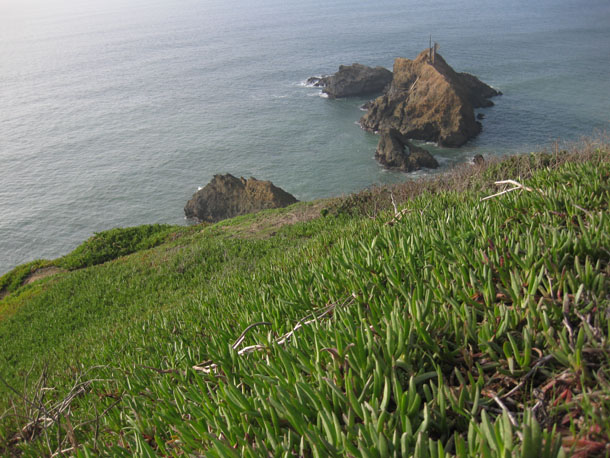
Mussel Rock is the site of the opening vignette of John McPhee’s Assembling California. He states (enigmatically to the non-geologists):
Mussel Rock is a horse.
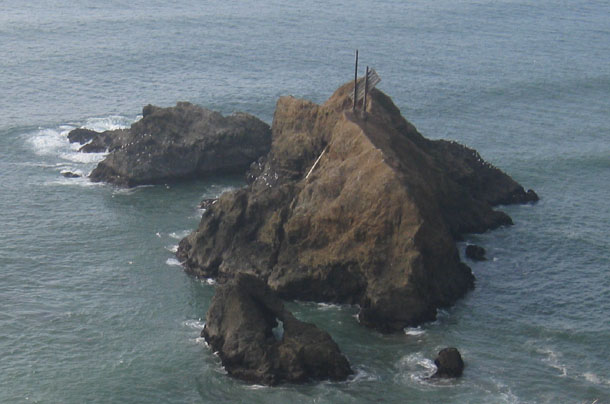
As any geologist will tell you, a horse is a displaced rock mass that has been caught between the walls of a fault. This one appeared to have got away. It seemed to have strained successfully to jump out of the continent.
It was a nice homage to McPhee, I thought, for me to make a pilgrimage (however brief) to this spot which I first read about so many years ago.
Thanks for joining me on this journey through a few of the rocks that San Francisco and its surrounding areas have to offer. What a great place to learn about geology!
31 December 2010
Friday fold: French Broad basement

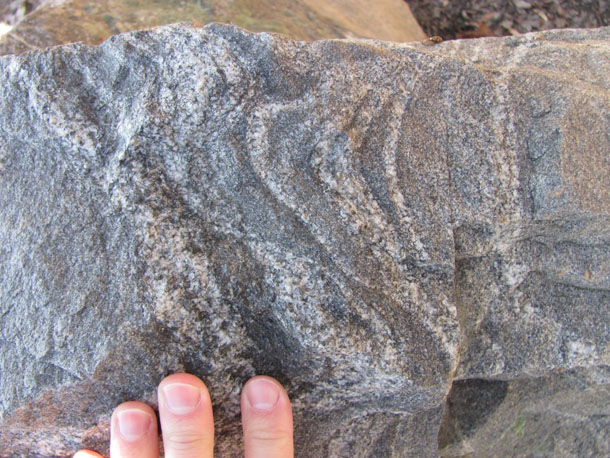
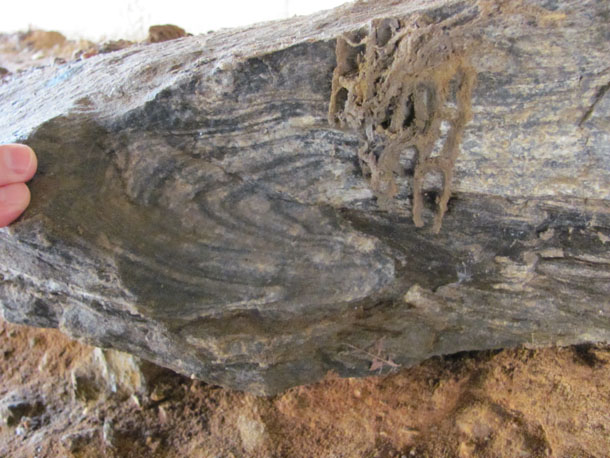
Folds in the gneiss that makes up the French Broad Massif of the Blue Ridge basement complex near Asheville, North Carolina.
A weathered mud dauber wasp nest adorns the last one.
Happy Friday, and Happy New Year’s Eve!
30 December 2010
A whopper of a mystery rock from the Golden State
When I was out in California in October 2009, about the same time that Garry Hayes passed me on the highway heading up to Yosemite while I was headed down towards the Modesto Airport, I pulled over to check out some rock exposures on the side of the road. This was near the Don Pedro Reservoir (right about here). While standing there, my attention was caught by a strange looking “rock” in a ~2 m wide hole at the side of the road.
Here’s what it looks like:
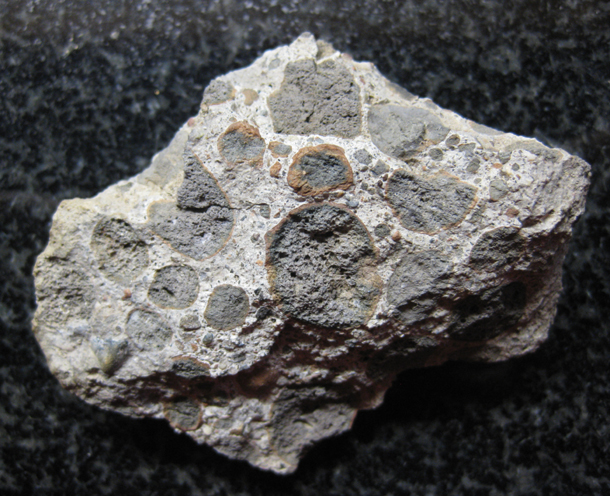
As you can see, it shows a “malted milk ball” (Whopper) texture, with dark spherules full of vesicles sitting in a light-colored, poorly-sorted matrix. The “orbs” have brown rims that are far less vesicular.
Here’s a close-up of the edge of the big central orb, shown with my patented* “animated focal plane” GIF technology.
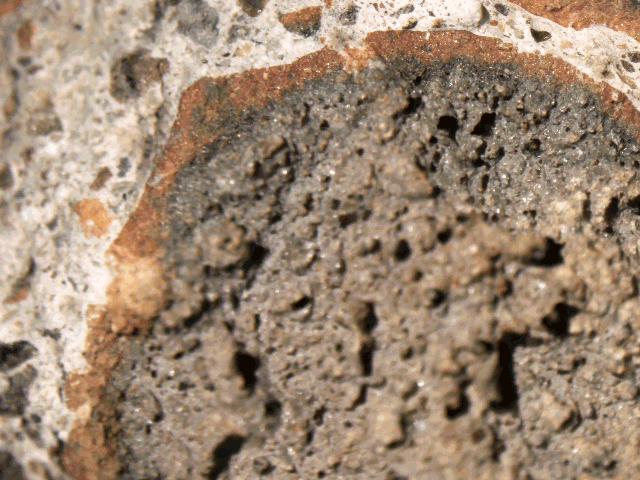
Field of view is about 1 cm. The dark little vesicular orbs and ellipsoids vary in size between 1 and 15 mm (long axis) are distributed in a matrix that looks suspiciously like concrete. These “Whoppers” have orangey brown (oxidized?) rinds.
What’s going on here?
Is this even natural? If you flip it over, you see this:

That looks a lot like an external mold of the flexible spiral-bound housing used to run cables through. So I guess it is concrete …of a kind I’ve never seen before. Where do the little orbs come from? Are they natural, only to be incorporated into an artificial “rock” (urbanite)? Or are they also manufactured?
Has anyone run into these vesicular “malt balls” in concrete before? Do tell!
________________________________
* Not really.


 Callan Bentley is Associate Professor of Geology at Piedmont Virginia Community College in Charlottesville, Virginia. He is a Fellow of the Geological Society of America. For his work on this blog, the National Association of Geoscience Teachers recognized him with the James Shea Award. He has also won the Outstanding Faculty Award from the State Council on Higher Education in Virginia, and the Biggs Award for Excellence in Geoscience Teaching from the Geoscience Education Division of the Geological Society of America. In previous years, Callan served as a contributing editor at EARTH magazine, President of the Geological Society of Washington and President the Geo2YC division of NAGT.
Callan Bentley is Associate Professor of Geology at Piedmont Virginia Community College in Charlottesville, Virginia. He is a Fellow of the Geological Society of America. For his work on this blog, the National Association of Geoscience Teachers recognized him with the James Shea Award. He has also won the Outstanding Faculty Award from the State Council on Higher Education in Virginia, and the Biggs Award for Excellence in Geoscience Teaching from the Geoscience Education Division of the Geological Society of America. In previous years, Callan served as a contributing editor at EARTH magazine, President of the Geological Society of Washington and President the Geo2YC division of NAGT.